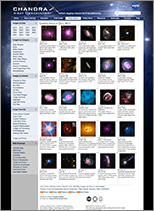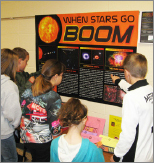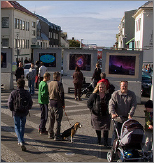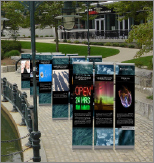
Goals: Effective and diverse access to high quality astrophysical content; effective and informed science communication
Outcomes: Engaged new audiences, increased science literacy, increased interest in NASA and its missions; targeted audiences have access to NASA resources tailored to their needs
Chandra Public Science: Since 2009, 1,752 exhibits have served many 10's of millions of people across 100 countries, in 40 languages. 2 O'Hare airport exhibits alone have attracted millions of viewers alone. More information on these projects: FETTU, FETTSS, LBTB
Materials designed to inspire and engage, such as the images from Chandra and the explanations behind the science results Activities to appeal to younger audiences adept at visual, electronic and social media communications interactives, a separate series of news releases for children Research to advance excellence in the presentation of science communication. |
A comprehensive, disabilities-accessible web site featuring such Web 2.0 elements as high definition (HD) video podcasts, blogs, user ratings and comments, interactive features and links to social media Public science activities ranging from interaction with Chandra data files to National Science Olympiad astronomy competitions to large-scale public exhibits Career-related blogs and podcasts, intern program |
We enhance NASA’s science story by presenting Chandra’s X-ray images in the context of a broader science picture, collaborating with Hubble, Spitzer, and many NASA or other telescopes to create multi-wavelength images. These have been used on the NASA portal and NASA-TV, NASA and other “picture of the day” sites, disseminated as exhibits to museums and planetariums, and used in informal and formal education products such as popular science books, text books, and electronic products. Availability of these high-quality images as well as original illustrations and animations has enabled Chandra science to be featured in broadcast productions and documentaries such as on PBS, the History Channel, the Smithsonian Channel, and Discovery Channel, and countless local broadcasts.
Aesthetics and Astronomy (http://astroart.cfa.harvard.edu.) is a research project that has revealed a series of “best practices,” which have been applied to Chandra visualizations and text used in press images, web presentations, multi-media products and public exhibits. The findings are reported in science communication journals and conference proceedings for the American Psychological Association. A blog-based web site was created to disseminate findings to outreach practitioners.
The Chandra web site (http://chandra.si.edu) serves not only as an up-to-date, quality repository for images and science results from Chandra, but also as host for the wealth of Chandra’s online and electronic resources that extend engagement for our public audiences: social media feeds, award-winning audio and video podcasts, blogs and multi-media interactives. The web site content has been recognized for excellence by science organizations and outside entities. The Chandra blog has been cited among the "100 Excellent Blogs for Science Teachers" by the Accredited On-Line Colleges Organization and is featured by the Christian Science Monitor and the Scripps Newspapers SpaceTimeNews site. Combined readership is in the millions.
Chandra's other multimedia and social media have continued to increase audience share. Twitter feeds and Facebook pages have followings in the tens of thousands, while the RSS feeds, podcasts and Youtube channel have viewship ranging from hundreds of thousands to over 1 million. Metrics and other data are available to demonstrate how effective these efforts have been at reaching a wide and diverse audience. The Chandra communications team prioritizes awareness of trending platforms and tools and adapts accordingly to be situated in the best places to respond and engage with the public.
Chandra communications also supports the National Science Olympiad astronomy competitions for middle and high school students. We have infused NASA science results into the competition tests, provided training and study outlines for the coaches and linked the team members and their coaches with NASA resources. The Science Olympiad fields 6800 teams at the local level and reaches over 100,000 students per year.
Since 2009, the Chandra communications group has conceived of, designed, and implemented large-scale projects referred to as "public science:" From Earth to the Universe (FETTU), From Earth to the Solar System (FETTSS), and Here, There and Everywhere (HTE). These projects have allowed Chandra and other NASA content to be placed in non-traditional venues such as public parks, shopping malls, and metro stations. These projects address the lack of understanding and awareness of STEM topics in the US, and evaluations of these efforts have shown demonstrable increases in interest and learning gains of these subjects. Moreover, these public science projects have reached underserved audiences such as Spanish speakers and visually impaired (through tactile-Braille and audio versions), thus broadening opportunities for engagement with NASA content. To date, these projects have been seen by tens of millions of people, and their impacts and effects have been documented in both scholarly journal articles and government reports as well as in keynote and invited talks at conferences and guest lectures at universities (see Reports). With comprehensive accompanying activities and sustainable websites, these open-access projects allow for deeper learning opportunities for interested visitors.
Another project, HTE, places NASA science in a wider context, through local and familiar examples "here" and global examples "there" before moving to cosmic examples from the universe, "everywhere". The travelling exhibit ran from 2012-2015 with stops at dozens of small libraries, as well as community centers, schools and science museums. Large-scale posters with the same content enabled other local organizations to provide content at additional venues.
In 2014, Chandra was selected to run the "Light: Beyond the Bulb" project for the UN's International Year of Light and Light-based Technologies 2015. Light: Beyond the Bulb (LBTB) is an open-source international exhibition program that showcases the incredible variety of light-based science being researched today across the electro-magnetic spectrum (from radio waves to gamma rays) and across scientific disciplines (from microbiology to astronomy). The exhibit materials and striking images were crowd-sourced and then expert-curated for science content, high-quality printability, stunning beauty and ability to engage the greater public. As of October 2015, there have been over 600 exhibit sites around the world, with over 35 participating countries, and more than a dozen language translations. Exhibit sites have ranged from an airport in New Zealand to a public square in Serbia to schools in China to the U.S. Senate Rotunda in Washington, D.C., USA. An updated list of exhibit locations may be found at http://lightexhibit.org/iylexhibits.html with select exhibit photos at http://lightexhibit.org/exhibit_photos.html
Chandra's public science projects have been prototyped and evaluated by external experts and those results have also shown the creation of new informal science education networks, content dissemination and additional capacity building which empowers local organizations as trusted science outreach organizers for their community.










